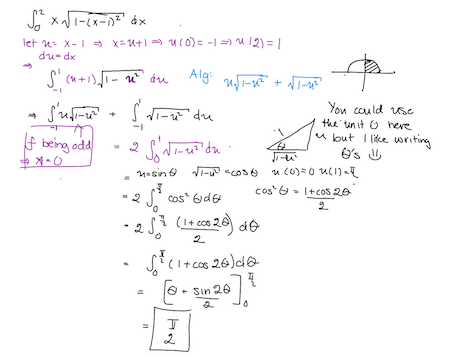This Semis -- I Mean Seems Familiar
∫ 0 2 x 1 − ( x − 1 ) 2 d x = ?
Give your answer to 2 decimal places.
The answer is 1.57.
This section requires Javascript.
You are seeing this because something didn't load right. We suggest you, (a) try
refreshing the page, (b) enabling javascript if it is disabled on your browser and,
finally, (c)
loading the
non-javascript version of this page
. We're sorry about the hassle.
2 solutions
Moderator note:
You can simplify your second integral by considering the unit circle. Do you see why?
As the Challenge Master notes, the second integral represents the area of a unit semicircle, which has area 2 π .
Came to 2 1 ∫ ( 1 + cos ( 2 θ ) ) d θ and then only solved ∫ cos ( 2 θ ) d θ = 0 f o r g i v e n l i m i t s . and put the answer as 0!! as I often do.
If you put it that way yes answer is pi/2 but if use arcsin(-1) =3pi/2 then the final answer would be -pi/2
Log in to reply
The range of the arcsin function is [ − 2 π , 2 π ] , with arcsin ( − 1 ) = − 2 π , making the final answer 2 1 ( arcsin ( 1 ) − arcsin ( − 1 ) ) = 2 π . Also note that the integrand is non-negative over the interval [ 0 , 2 ] , so the value of the integral cannot be negative.
I know this is an almost unnecessary comment: But for anyone tempted to pick up that calculator on the final step.... no need! Just a reminder: Long division works on pi too..... 3.1415 / 2 = 1.57
my mistake: i thought arcsin − 1 = 3 π / 4 instead of − π / 4
Why odd function equals 0?
Log in to reply
This trick only works when the bounds of the integral are a and − a . The areas on the left hand and right side of such a graph cancel out. Consider sin x for example ... ?
Why don't you first apply some techniques of definite integral and then solve indefinite It would be quite easier

First let u = x − 1 . Then x = u + 1 , d u = d x and as x : 0 → 2 we have u : − 1 → 1 . The integral then becomes
∫ − 1 1 ( u + 1 ) 1 − u 2 d u = ∫ − 1 1 u 1 − u 2 d u + ∫ − 1 1 1 − u 2 d u .
Now the integrand of the first of these integrals is an odd function, and since we are integrating from − 1 to 1 , this integral evaluates to 0 . Thus we just need to focus on the second of these integrals.
Letting u = sin ( θ ) , we have that d u = cos ( θ ) d θ and 1 − u 2 = cos ( θ ) . The (indefinite) integral then becomes
∫ cos 2 ( θ ) d θ = 2 1 ∫ ( 1 + cos ( 2 θ ) ) d θ =
2 1 ( θ + sin ( θ ) cos ( θ ) ) = 2 1 ( arcsin ( u ) + u 1 − u 2 ) ,
which when evaluated from − 1 to 1 yields 2 1 ( ( arcsin ( 1 ) + 0 ) − ( arcsin ( − 1 ) + 0 ) ) =
arcsin ( 1 ) = 2 π = 1 . 5 7 to 2 decimal places.